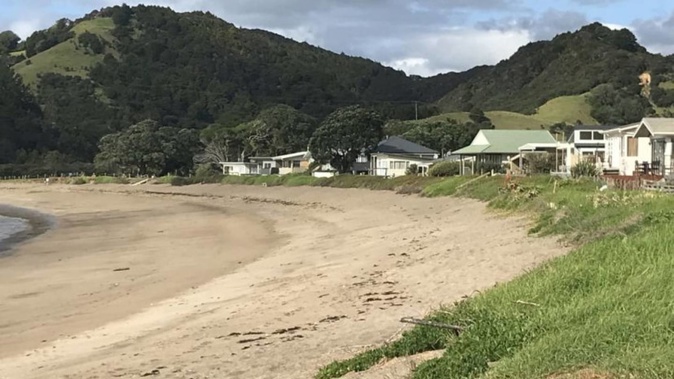

Coastal retreat may eventually be the best option for some affected Whangārei coastal communities facing expensive and ultimately short-term fixes to deal with foreshore sand dune erosion, a council specialist is warning.
Matapōuri, Oakura, Teal Bay, Whangaumu and Whananaki have all been storm affected, with the loss of sand creating concerns around losing waterfront homes, Whangārei District Council (WDC) parks and reserves manager Sue Hodge said.
She said council mahi towards replenishing sand dunes eroded by Cyclone Gabrielle and other storms before that, would follow nature-based solutions. These would potentially involve scraping sand off the beach and stacking it back onto the front of dunes in conjunction with appropriate planting.
This would need to be repeated every five to 10 years. That would be challenging when people could see this preferred solution would not last long.
Faced with this prospect, the final solution was probably managed retreat in the future, she told WDC councillors at a briefing on Wednesday.
She said coastal development allowed 50 years ago in some of the affected areas would today be treated quite differently. Northland Regional Council (NRC) coastal hazard maps now had foreshore erosion and flooding hazard lines running through foreshore houses.
“We are seeing the impacts of more frequent and severe weather events while at the same time coastal development and impacts threatening private property are increasing, resulting in tension between owners and council [both regional council and district council],” Hodge said.
/cloudfront-ap-southeast-2.images.arcpublishing.com/nzme/5LCH3EATNRBVDGOCURT42IGJUU.jpg)
Nature-based solutions such as this September 2022 CoastCare group dune restoration with planting at Langs Beach are the best approach to protect Whangārei's vulnerable coastal settlements and shorelines, according to WDC. Photo / LDR
“There are increasing calls to the district council to ‘hold the line’ and stop coastal erosion, particularly at beaches with a narrow area between houses and the dynamic part of the beach [the dune system].”
Hodge said WDC was under pressure to provide a fix, even though the council was effectively not legally required to do so on private land or its own public land.
“During [Cyclone Gabrielle] significant sand was lost from Whangaumu (Wellingtons Bay), Oakura and Matapōuri beaches, resulting in calls from property owners to allow them to build hard structures to protect their homes and for council to take action,” Hodge said.
She said hard surfaces such as rock walls in these environments did not fix the problem, but made it worse, resulting in large areas of beach at their base disappearing.
Nature-based solutions were the soft engineering preference based on protection, creation, enhancement and restoration of natural coastal features such as beaches and dunes, and included biodiversity outcomes.
She said concerns around coastal erosion had also been raised in Tūtūkākā's Church Bay, Teal Bay and Whananaki North in 2022.
Hodge said storms could cause the sudden disappearance of the front of sand dunes in just a couple of hours. Their sand would naturally return over time, but this could take five to 10 years.
Communities were concerned about those comparative time scales.
/cloudfront-ap-southeast-2.images.arcpublishing.com/nzme/43BO242YUVD47JCNLHBJ4ULMLQ.jpg)
A simple Northland message for sand dune health. Photo / LDR
“Understandably, some property owners feel their properties are at risk now and don’t want to wait for the natural rebuilding process and want the council to undertake some sort of protection immediately,” Hodge said.
NRC had identified 19 high-risk coastal areas along Whangārei’s coastline based on sea level rise, erosion and river or coastal flooding.
These were from north to south along Whangārei’s coastline: Oakura, Helena Bay, Whananaki, Woolleys/Sandy Bay, Matapōuri, Tūtūkākā, Ngunguru, Pātaua, Taiharuru, Whangārei, Waikaraka/Tamaterau, Whangārei Heads, Takahiwai, Marsden, Ruakāka, Waipū, Waipū Cove and Langs Beach.
WDC is a signatory to the 2022 Tai Tokerau Climate Adaptation Strategy, New Zealand’s first region-wide inter-council agreement of its type.
Hodge said it was important council coastal management was in line with the strategy and long- term climate adaptation work. This could, however, take time.
“The challenge in managing these demands is to ensure any decisions or actions we might take now align with short-term options we might develop with the community as part of adaptation planning,” Hodge said.
“There is a risk we might implement something that is inconsistent with the community-developed action plan.”
She said the coastal management would need to be led by the local community such as through CoastCare and have support to plant and maintain restored dunes with appropriate dune plants, not exotics.
Coastal management had to be carried out across the length of the affected areas.
“You can’t have just one property without doing them all,” she said.
Targeted rates for affected communities and a contestable fund for those, such as Whangaumu which is already working on its own soft engineering solutions, were among council funding options, Hodge said.
/cloudfront-ap-southeast-2.images.arcpublishing.com/nzme/BZLXVFMX6WQ7ZDN6QOOFOZCOZU.jpg)
Take your Radio, Podcasts and Music with you









